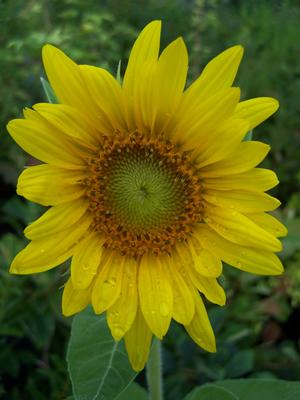Part IV: Feeding in Winter
Winter is the toughest season for birds. A hard winter when snows accumulate for weeks or months on end can devastate many numbers. For ground-feeders which so many are in this season the blanket of snow cuts-off access to seed and berries strewn upon the surface which just weeks before still clung to pedicels atop drying autumn plants.
Feeding at this time is a wonderful pastime and of strategic import, too. Choose seed mixes with various plant species represented, those running the gamut from tiny seeds to larger. Mixes with numerous kinds and sizes including grasses such as corn and millet plus thistle, sunflower (see pic 1) and peanuts will attract more birds. And you can augment a blend by simply supplementing it with seeds not included in the mix.
So many feeder styles are available. It would be better to spend a little more money purchasing those of sturdier construction formed of better materials. And unless you don’t mind squirrels greedily stuffing themselves with seed you have intended for the feathered ones then I strongly recommend buying ready-made cages in which feeders fit. Sometimes they come together as sets. The cages’ gaps are large enough to allow the birds through to the perches where they may dine in peace. But the gaps are too small to allow larger marauders entry.
Place feeders where you can view them from your home’s windows and doors. We find this brand of bird watching an endless source of entertainment. And you are performing an act of kindness for creatures which often benefit from a helping hand during the cold months. They will return the kindness with a fascinating procession of antics and beauty.
Suet feeders also come in a variety of styles and sizes. Attach them directly to posts or deck railings (see pic 2). Or use a short piece of chain supporting them from easily reached decorative hangers attached to a deck post. Or hang them from lower tree branches. They will sway with abandon in breezes but not spook hungry birds that relish this fattening treat. Suet is inexpensive and can be purchased from grocery stores or slaughter houses. These wire feeders are also excellent vessels to hold halved fruits such as apples or oranges. Fruits are also attractive food sources for many species including Baltimore Orioles which summer in northeastern Connecticut. It is important every now and again to collect all feeders and wash them in warm soapy water. This diminishes the possible spread of diseases.
Shallow open water sources are most beneficial especially in particularly cold winters when temperatures may not rise above 32F for consecutive days. In very cold periods thaw puddles will not collect from which the birds may drink.
Another rewarding project is making the “woodpecker feeder log”. Choose a piece of log about 18 inches tall by at least 6 inches wide. Drill one inch diameter holes to two and one-half inches deep setting the holes a few inches apart from each other. Drill them in an artful spiral from top to bottom or simply in four or five up and down rows. This feeder can be mounted atop a post. Or with the use of an eye hook positioned at its top-center hanging it from a sturdy tree branch using a small chain. (If concerned a chosen tree branch may incur damage from bare chain string it through plastic tubing so that the bark will be protected.) Into its holes I stuff the mix from the following recipe: combine one pound of lard with 2 cups of all-purpose flour, 2 cups of yellow cornmeal with 2 cups of any other kind of flour you may have on hand. I blend this by hand into a pliable mix with the consistency of Play Dough. If too sticky add a little more meal or flour until it is a bit stiffer and doesn’t collect on your fingers. We leave this mix un-refrigerated as it will stay fresh for many weeks.
This food is a magnet for an extensive number of species including Red-bellied (see pic 3), Downy and Hairy Woodpeckers, Flickers, Cardinals, Juncos, White-throated, Song and Chipping Sparrows, Carolina and House Wrens, Colorado House Finches, Nuthatches, Blue Jays and Pine Siskins. Bright-eyed Titmice and Black-capped Chickadees (see pic 4) loosely flock together in winter raiding seed from feeders though both are partial to this mix as well. Mourning Doves enjoy the remaining tiny crumbs on the deck.
Breeding Robins discovered the treat during the spring of 2012. Migrating Rusty Blackbirds always come in early spring and mid-autumn. Once we even watched a hungry, migrating Yellow-bellied Sapsucker eating contentedly. The lard augments the flour with a much-needed fat source buffering against winter cold. Curiously, there have been many mornings when I have begun to fill this feeder when suddenly I heard the piercing electric voice of the Red-bellied Woodpecker repeating “churrrr” from a not distant vantage. I cannot help but feel as this happens with frequency that I am being watched and the announcing bird is awaiting its treat in joyous anticipation! Stay tuned.


